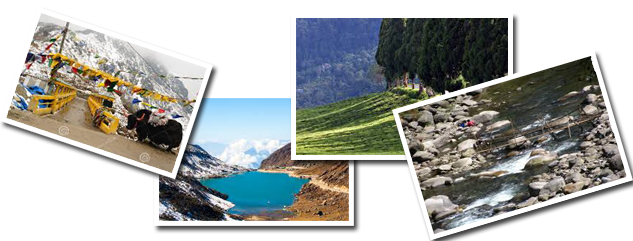







Popular Tour Packages
Our Special Treks

Sikkim (A Mountain State)
A mountain state in the indian himilayas,the country was originally known by many names including Lho Jong, 'The Valleys of the South',Lho Mon Kha Shi, 'The Southern Mon Country of Four Approaches', Lho Jong Men Jong, 'The SouthernValleys of Medicinal Herbs and Lho Mon Tsenden Jong, 'The Southern Mon Valleys where Sandlewood Grows'.Mon was a term used by the Tibetans to refer to Mongoloid, non-Buddhist peoples that populated the Southern Himalayas.
The country came to be known as Druk Yul or The Land of the Drukpas sometime in the 17th century.Initially Bonism was the dominant religion in the region that would come to be known as Bhutan. Buddhism was introduced in the 7th century by the Tibetan King Songtsen Gampo and further strengthened by the arrival of Guru Rimpoche, a Buddhist Master that is widely considered to be the Second Buddha.
country was first unified in 17th century by Zhabdrung Ngawang Namgyel. After arriving in Bhutan from Tibet he consolidated his power, defeated three Tibetan invasions and established a comprehensive system of law and governance. His system of rule eroded after his death and the country fell into in-fighting and civil war between the various local rulers.
This continued until the Trongsa Poenlop Ugyen Wangchuck was able to gain control and with the support of the people establish himself as Bhutan's first hereditary King in 1907. His Majesty Ugyen Wangchuck became the first Druk Gyalpo (Dragon King) and set up the Wangchuck Dynasty that still rules today.
Cultures
Its major towns like Gangtok the capital city, Namchi and Jorethang already are urbanizing at a steady pace.More and more people are being attracted by business opportunities andgradually imbibing the cosmopolitan character.
Though Sikkim is predominantly a Buddhist state its spirit is secular and here churches, monasteries, gurdwaras,mosques andtemples co-exist peacefully. It is hard to define the true culture of Sikkim ? it could best be called a wonderful mosaic, a unique pattern made beautiful by the unusual harmony in its individually colourful threads.And that is itstrait.
The predominant communities are the Lepchas, the Bhutias and the Nepalese and overthe years there have been inter-racial marriages among the three.
Peoples
The Lepchas are the natives of Sikkim with very little known about their origin. A theory hasit that the Lepchas moved in from the borders of Assam and Burma while another speaks of themmigrating from Southern Tibet. But basically they are of mongoloid stock.
The Bhutias are purely of Tibetan origin who migrated to Sikkim from Tibet somewhere after the fifteenth century. The language of the Bhutias is Sikkimese, a dialect of the Tibetan language and are mostly Buddhists.A predominant Bhutia population inhabits North Sikkim in the villages of Lachung and Lachen.
The Nepalese who migrated from Nepal from the mid-nineteenth century form the dominant population. It was the British who patronized the Nepalese for their warlike qualities and integrity and raised an entire army consisting purely of Nepalese soldiers. They were also allowed to settle down in the hill tracts belongingto British India. In Sikkim the Chogyal had granted a lease to some Nepalese traders sometime in the year 1860.
Tsongmo (Changu) Lake
Baba Mandir
Aritar Lake
Nathula Pass (China Border)
Handloom & Handicraft
Ropeway
Bakthang Waterfalls

Our Adventures
- Mountain Biking
Sikkim's best adventure product is mountain biking The rugged and dramatic terrain of Sikkim Himalayas offers sure and exciting biking...
- River Rafting
Is one of the latest adventure sport in Sikkim. Only the Teesta and Rangit rivers offer long stretches which are ideal for safe rafting...
- Paragliding
Paragliding in Gangtok is becoming an increasingly popular adventure sports.
Our Destinations
- Sikkim
The country was originally known by many names including Lho Jong, 'The Valleys of the South',Lho Mon Kha Shi, 'The Southern Mon Country of Four Approaches...
- Darjeeling
the city is also famous for the darjeeling himalayan railways which is one among the unesco world heritage list. There are a large number of tourist destinations...
- Kalimpong
This exotic town of beautiful people, mystical and enchanting, with a rare ethnic blend of hill people, has a tradition of hospitality...
- Bhutan
Bhutan is one of the smallest countries in the world, its cultural diversity and richness are profound.As such, strong emphasis is laid on the promotion...